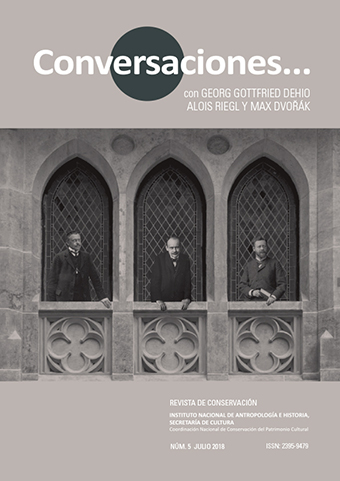More than modern, contemporary. Riegl and the protection of cultural heritage in the last decade
Publicado 2018-09-27
Palabras clave
- Theory of values,
- antiquity value,
- world heritage,
- global conservation,
- memory
- patina ...Más
Cómo citar
Resumen
Although it has been more than a century since its publication, the Moderne Denkmalkultus still occupies a prominent place in the international culture of conservation, especially considering the global presence it has acquired in the last decade. Considered a true theoretical and methodological pillar on which were based the concepts of monument, memory and heritage, which structure the Western cultural landscape, Riegl’s thinking does not seem to have aged. Instead, it continues to offer food for thoughts, even if the coordinates of today’s global protection have well transcended the European geo-cultural borders, and refer by now to deeply changed philosophical and axiological references to the past. The reasons for this affinity between the reflection of the Austrian intellectual and the current issues of memory conservation go back essentially to the strong vanguard of his thinking: Riegl went beyond the historical-critical limits established by European culture to the theory of restoration during the 19th century and laid the foundations of a conscious and updated approach at the time, in open dialogue with a society in deep transformation and whose cultural capacity was maturing in proportion to its own development. What today still marvels of Riegl’s thinking is the relevance of his early 20th-century “theory of values” compared to the relationship between contemporary culture and objects of the past, centered on emotional, affective or intellectual reactions that stimulate the individual and the community. For these and other reasons, it may be useful to reconsider the range of discourses that still lead us to appeal to Riegl and to his Denkmalkultus, which still remains among the most cited, recalled and beloved theoretical references in the literature concerning the transmission of the memory of the past.
Descargas
Referencias
Weimar.
Carpo, Mario (2007) “The Post-Modern Cult of Monuments”, Future anterior 4 (5): 51-62.
Choay, Françoise (1992) L’allégorie du patrimoine, Editions du Seuil, Paris.
Choay, Françoise (1995) “Riegl, Freud e i monumenti storici. Per un approccio “societale” alla conservazione”, in: Sandro
Scarocchia (a cura di), Alois Riegl: teoria e prassi della conservazione dei monumenti. Antologia di scritti, discorsi, rapporti 1898- 1905, con una scelta di saggi critici, Accademia Clementina, Clueb, Bologna, pp. 455-465.
Convenzione di Faro (2005) Convenzione quadro del Consiglio d’Europa sul valore dell’eredità culturale per la società [https://goo.gl/UFHJf5] (consultato il 20 gennaio 2018).
Frodl, Walter (1987) “Wandlungen im Konzept der Denkmalpflege in letzen halben Jahrhundert”, Denkmalschutz Informationen, 11; in: Donatella Fiorani (a cura di), Il restauro architettonico nei paesi di lingua tedesca. Fondamenti, dialettica, attualità, Bonsignori, Roma, pp. 119-122.
Frodl, Walter (1995) “Concetti valori di monumento e il loro influsso sul restauro”, in: Sandro Scarrocchia (a cura di), Alois Riegl:teoria e prassi della conservazione dei monumenti. Antologia di scritti, discorsi, rapporti 1898-1905, con una scelta di saggi critici, Accademia Clementina, Clueb, Bologna, pp. 401-422.
Giannattasio, Caterina (2010) “Lo spazio esistenziale e l’istanza psicologica: attualità del pensiero di Roberto Pane”, in: Stella Casiello, Andrea Pane, Valentina Russo (a cura di), Roberto Pane tra storia e restauro. Architettura, città, paesaggio, atti del Convegno Nazionale di Studi, Napoli 27-28 ottobre 2008, Marsilio, Venezia, pp. 154-158.
Grimoldi, Alberto (2005) “Traduzioni e traduttori: le parole e la cosa”, Ananke (74): 13-18.
Grubser, Michael (2005) “Time and history in Alois Riegl’s theory of perception”, Journal of the history of ideas 66 (3): 451-474.
Harrer, Alexandra (2017) “The legacy of Alois Riegl: material authenticity of the monument in the digital age”, Built heritage (2):29-55.
Jokilehto, Jukka (1999) A history of architectural conservation, Butterworth Heinemann, Oxford.
Jokilehto, Jukka (2006) “Preservation theory unfolding”, Future anterior III (1): 1-9.
Jokilehto, Jukka (2015) “Conservation ethics from Riegl’s time to the present”, Modern conservation (3): 11-23.
Korth Thomas (1983) “Denkmalpflege. Uberlegungen zum Hundertjärigen bestehen eines begriffs”, Deutsche Kunst und Denkmapflege 41 (2): 2-9; in: Donatella Fiorani (a cura di), Il restauro architettonico nei paesi di lingua tedesca. Fondamenti,
dialettica, attualità, Bonsignori, Roma, pp. 43-52.
Riegl, Alois (1901) Die_ spätrömische Kunst-Industrie_ nach den Funden in Österreich-Ungarn im Zusammenhange mit der Gesamtentwicklung der Bildenden Künste bei den Mittelmeervölkern, Edizioni dello Stato Austriaco, Vienna.
Riegl, Alois (1905) “Neue Strömungen in der Denkmalpflege”, in: Mitteilungen der K. K. Zentralkommission für Erforschung
und Erhaltung der Kunst- und historischen Denkmale, 3, pp. 85-104; trad. it. “Nuove tendenze nella conservazione”, in: Sandro Scarocchia (a cura di), Alois Riegl: teoria e prassi della conservazione dei monumenti. Antologia di scritti, discorsi, rapporti 1898-1905, con una scelta di saggi critici, Accademia Clementina, Clueb, Bologna, pp. 291-302.
Scarrocchia, Sandro (1995) Alois Riegl: teoria e prassi della conservazione dei monumenti. Antologia di scritti, discorsi, rapporti 1898-1905, con una scelta di saggi critici, Accademia Clementina, Clueb, Bologna.
Scarrocchia, Sandro (2006) “La ricezione della teoria della conservazione di Riegl fino all’apparizione della teoria di Brandi”, in: Maria Andaloro (a cura di), La teoria del restauro da Riegl a Brandi, atti del convegno internazionale, Viterbo 12-15 novembre 2003, Nardini, Firenze, pp. 305-332.
Scarrocchia, Sandro (2008) “La ricezione di Riegl in Italia dalla Carta di Venezia ad oggi”, in: Alois Riegl (1858-1905). Un secolo dopo, atti dei Convegno dei Lincei, Roma 30 novembre - 2 dicembre 2005, Bardi, Roma, pp. 35-50.
Schmitz, Hermann (2016) “Atmospheric spaces”, Ambiances, online [http://ambiances.revues.org/711] (consultato il 27 dicembre 2017).
Thordis, Arrehnius (2004) “The cult of age in mass-society: Alois Riegl’s theory of conservation”, Future anterior 1 (1): 75-81.
Tomaszewski, Andrzej (2005) “I valori immateriali dei beni culturali nella tradizione e nella scienza occidentale”, in: Simonetta Valtieri (a cura di), Della bellezza ne è piena la vista! Restauro e conservazione alle latitudini del mondo nell’era dellaglobalizzazione, Atti del convegno, Reggio Calabria 10-12 luglio 2003, Nuova Argos, Roma, pp. 30-55.

